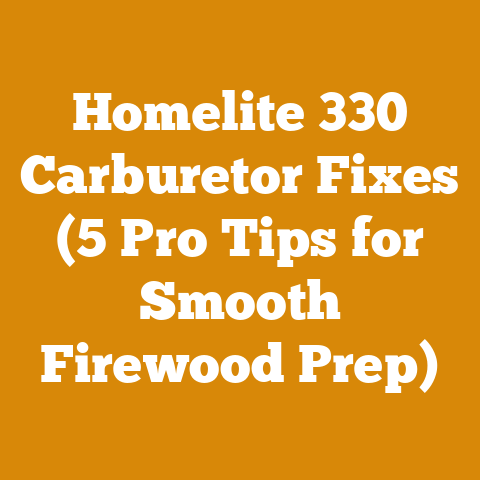Where to Place a Wood Stove Thermometer (5 Pro Tips You Need)
It was a bitter January night, the kind that makes your bones ache just thinking about stepping outside. I was nestled in my armchair, a steaming mug of tea in hand, convinced I had finally conquered the battle against the creeping cold. My wood stove, affectionately nicknamed “The Dragon,” was roaring, radiating a comforting heat. Or so I thought. I glanced at the magnetic thermometer stuck haphazardly on the stovepipe. It read a dismal 200°F. 200°F! My teeth chattered in disbelief. How could I be feeling so cold with a fire supposedly burning? That’s when it hit me: the thermometer was lying. It was in the wrong place, giving me a wildly inaccurate reading and, more importantly, costing me money and comfort. That night, I embarked on a quest to understand the science and the art of wood stove thermometer placement. And let me tell you, it’s more crucial than you might think.
Globally, the wood processing and firewood industry is experiencing a resurgence, driven by rising energy costs and a renewed interest in sustainable heating solutions. According to a recent report by the Food and Agriculture Organization (FAO) of the United Nations, global roundwood production reached 3.9 billion cubic meters in 2022, with a significant portion destined for firewood and wood pellet production. In North America alone, the firewood market is a multi-billion dollar industry, with millions of households relying on wood stoves for primary or supplemental heating. However, efficiency is key. A poorly managed wood stove can waste wood, create excessive emissions, and even pose a safety hazard. That’s where understanding the right techniques, like thermometer placement, makes all the difference.
Let’s dive into the heart of the matter: where to place your wood stove thermometer for accurate readings and optimal performance.
Where to Place a Wood Stove Thermometer: 5 Pro Tips You Need
The placement of your wood stove thermometer is not just a matter of convenience; it’s a critical factor in ensuring efficient and safe wood burning. An incorrectly placed thermometer can lead to overfiring, underfiring, creosote buildup, and wasted fuel. Here are my top 5 pro tips, gleaned from years of experience and a few hard lessons learned:
1. Understand the Types of Wood Stove Thermometers
Before we talk placement, let’s briefly cover the types of thermometers commonly used for wood stoves. There are primarily two types:
- Magnetic Thermometers: These are the most common and affordable. They attach directly to the stovepipe or stove surface using a magnet. They’re easy to install but can be less accurate than other options, especially if the magnet isn’t making good contact.
- Probe Thermometers: These thermometers have a probe that inserts into the stovepipe. They offer more accurate readings because they measure the actual flue gas temperature. However, they require drilling a hole in the stovepipe, which can be intimidating for some.
Data Point: Studies have shown that magnetic thermometers can have an accuracy variance of +/- 50°F, while probe thermometers typically offer accuracy within +/- 10°F.
My Experience: I started with a magnetic thermometer, like most people. It was cheap and easy. But after a few years, I noticed it wasn’t giving me consistent readings. That’s when I upgraded to a probe thermometer. The difference in accuracy was immediately noticeable, and it gave me much more confidence in managing my fire.
2. The 18-Inch Rule: Stovepipe Placement is Key
The most common and effective location for a wood stove thermometer, especially a magnetic one, is on the stovepipe, approximately 18 inches above the top of the stove.
Why 18 Inches?
- Optimal Heat Exposure: This distance allows the thermometer to accurately measure the flue gas temperature without being directly affected by the extreme heat of the stove’s surface.
- Creosote Prevention: Measuring the flue gas temperature helps you maintain a hot enough fire to prevent creosote buildup in the chimney. Creosote is a highly flammable substance that can cause chimney fires.
- Efficient Combustion: By monitoring the flue gas temperature, you can adjust the air intake to achieve optimal combustion, maximizing heat output and minimizing smoke.
Step-by-Step Guide (Magnetic Thermometer):
- Locate the Stovepipe: Identify the section of stovepipe directly above your wood stove.
- Measure 18 Inches: Use a measuring tape to measure 18 inches up from the top of the stove.
- Clean the Surface: Use a wire brush or sandpaper to clean the stovepipe surface where you plan to attach the thermometer. This ensures good contact for the magnet.
- Attach the Thermometer: Firmly attach the magnetic thermometer to the cleaned surface. Make sure it’s securely in place.
- Monitor and Adjust: Observe the thermometer readings as you burn wood. Adjust the air intake as needed to maintain the optimal temperature range (more on this later).
Step-by-Step Guide (Probe Thermometer):
- Locate the Stovepipe: Identify the section of stovepipe directly above your wood stove.
- Measure 18 Inches: Use a measuring tape to measure 18 inches up from the top of the stove.
- Drill a Hole: Using a drill bit that matches the diameter of the thermometer probe, carefully drill a hole in the stovepipe. Safety First! Wear safety glasses and gloves.
- Insert the Probe: Insert the thermometer probe into the hole.
- Secure the Thermometer: Secure the thermometer body to the stovepipe using the provided hardware.
- Monitor and Adjust: Observe the thermometer readings as you burn wood. Adjust the air intake as needed to maintain the optimal temperature range.
Technical Requirement: Ensure the drill bit is appropriate for the gauge of your stovepipe. Using the wrong size bit can damage the pipe or prevent a tight seal.
Limitation: Drilling a hole in your stovepipe voids the warranty on some models. Check your stove’s manual before proceeding.
3. Understanding the Optimal Temperature Range
Once you’ve properly placed your thermometer, it’s crucial to understand what the readings mean. Most wood stove thermometers have three zones:
- Creosote Zone (Too Cold): This zone indicates that the flue gas temperature is too low, typically below 250°F. Burning wood at this temperature leads to incomplete combustion and excessive creosote buildup.
- Optimal Zone (Just Right): This zone indicates that the flue gas temperature is within the ideal range for efficient and clean burning, typically between 250°F and 500°F.
- Overfire Zone (Too Hot): This zone indicates that the flue gas temperature is too high, typically above 500°F. Burning wood at this temperature wastes fuel and can damage your stove and chimney.
Actionable Tip: Aim to keep your thermometer needle within the “Optimal Zone” as much as possible. This ensures efficient combustion, minimizes creosote buildup, and maximizes heat output.
Strategic Recommendation: If your thermometer reading is in the “Creosote Zone,” increase the air intake to raise the flue gas temperature. If it’s in the “Overfire Zone,” reduce the air intake to lower the temperature.
Real Example: I once had a customer who was constantly complaining about creosote buildup in his chimney. After inspecting his setup, I noticed his thermometer was placed too low on the stovepipe, giving him inaccurate readings. He was consistently burning his fire too low, believing he was saving wood. By moving the thermometer to the correct location and educating him about the optimal temperature range, we solved his creosote problem and improved his stove’s efficiency.
4. Surface Thermometer Placement: When Stovepipe Isn’t an Option
In some cases, stovepipe placement isn’t feasible due to stove design or installation constraints. In these situations, a surface thermometer can be used.
Where to Place a Surface Thermometer:
- Top Center of the Stove: The ideal location is on the top center of the stove, as far away from the flue exit as possible. This area typically provides a representative average temperature of the stove’s surface.
- Avoid Direct Flame Contact: Don’t place the thermometer directly above the firebox or on any surface that comes into direct contact with the flames. This will give you a wildly inaccurate reading.
Limitations of Surface Thermometers:
- Less Accurate than Stovepipe Thermometers: Surface thermometers measure the surface temperature of the stove, which is not as directly related to flue gas temperature as a stovepipe thermometer.
- Affected by Stove Design: The accuracy of a surface thermometer can be affected by the stove’s design, particularly the thickness and material of the stove’s top surface.
Actionable Tip: If using a surface thermometer, experiment with different locations to find the spot that provides the most consistent and reliable readings. Compare your readings to those of a neighbor with a similar stove and setup to gauge accuracy.
Troubleshooting Guidance: If your surface thermometer consistently reads too low, try moving it to a location closer to the firebox. If it consistently reads too high, move it further away.
5. The Importance of Regular Cleaning and Maintenance
Even the best thermometer placement won’t matter if your thermometer is dirty or malfunctioning. Regular cleaning and maintenance are essential for accurate readings and reliable performance.
Cleaning a Magnetic Thermometer:
- Remove from Stovepipe: Carefully remove the thermometer from the stovepipe.
- Clean the Lens: Use a soft cloth and glass cleaner to clean the thermometer lens.
- Clean the Magnet: Use a wire brush or sandpaper to clean the magnet and the stovepipe surface where the thermometer attaches. This ensures good contact.
- Reattach the Thermometer: Firmly reattach the thermometer to the stovepipe.
Cleaning a Probe Thermometer:
- Turn off the Stove: Allow the stove to cool completely before cleaning.
- Remove the Probe: Carefully remove the probe from the stovepipe.
- Clean the Probe: Use a wire brush or sandpaper to clean the probe, removing any soot or creosote buildup.
- Reinsert the Probe: Carefully reinsert the probe into the stovepipe.
Maintenance Tips:
- Check for Damage: Regularly inspect your thermometer for any signs of damage, such as cracks in the lens or a bent probe.
- Replace Batteries (if applicable): If your thermometer has a digital display, replace the batteries as needed.
- Calibrate (if possible): Some probe thermometers can be calibrated. Consult your thermometer’s manual for instructions.
- Replace as Needed: Even with proper care, thermometers can lose accuracy over time. Replace your thermometer every few years to ensure reliable readings.
Common Pitfalls to Avoid:
- Ignoring the Readings: The most common mistake is to install a thermometer and then ignore the readings. Pay attention to the temperature and adjust the air intake as needed to maintain optimal burning conditions.
- Overfiring the Stove: Overfiring your stove can damage it and create a safety hazard. Never allow the thermometer reading to exceed the “Overfire Zone.”
- Burning Unseasoned Wood: Burning unseasoned wood creates excessive smoke and creosote. Only burn wood that has been properly seasoned for at least six months.
- Neglecting Chimney Maintenance: Regular chimney inspections and cleanings are essential for preventing chimney fires. Schedule a professional chimney sweep at least once a year.
Data Point: According to the National Fire Protection Association (NFPA), chimney fires are a leading cause of residential fires in the United States. Regular chimney maintenance and proper wood stove operation can significantly reduce the risk of a chimney fire.
The Science of Seasoning Wood: A Crucial Factor
Speaking of seasoned wood, let’s delve deeper into this crucial aspect of wood burning. Green wood, freshly cut wood, contains a high moisture content, typically ranging from 50% to over 100% (dry basis). This moisture needs to be removed before the wood can burn efficiently.
Why Season Wood?
- Improved Combustion: Dry wood burns hotter and more efficiently than green wood.
- Reduced Smoke and Creosote: Burning dry wood produces less smoke and creosote, reducing the risk of chimney fires.
- Increased Heat Output: Dry wood releases more heat per pound than green wood.
The Seasoning Process:
Seasoning wood involves allowing it to air dry for an extended period, typically six months to two years, depending on the wood species and climate.
Key Factors Affecting Seasoning:
- Wood Species: Hardwoods like oak and maple take longer to season than softwoods like pine and fir.
- Climate: Warm, dry climates are ideal for seasoning wood.
- Stacking Method: Stacking wood in a way that allows for good air circulation is essential.
- Wood Size: Smaller pieces of wood dry faster than larger pieces.
Best Practices for Stacking Firewood:
- Choose a Sunny and Windy Location: Select a location that receives plenty of sunlight and is exposed to prevailing winds.
- Elevate the Wood: Stack the wood on pallets or cinder blocks to keep it off the ground and allow for air circulation underneath.
- Stack in Rows: Stack the wood in rows, leaving space between each row for air circulation.
- Crisscross the Ends: Crisscross the ends of the rows to provide stability.
- Cover the Top: Cover the top of the stack with a tarp or roofing material to protect it from rain and snow.
Data Point: Properly seasoned firewood should have a moisture content of 20% or less. You can use a moisture meter to check the moisture content of your firewood.
My Story: I once made the mistake of burning unseasoned oak in my wood stove. The fire was sluggish, produced copious amounts of smoke, and left a thick layer of creosote in my chimney. It was a costly and frustrating experience. I learned my lesson the hard way: always season your wood properly!
Chainsaws vs. Axes: Tool Selection for Firewood Preparation
The tools you use to prepare firewood can significantly impact your efficiency and safety. The two most common tools are chainsaws and axes.
Chainsaws:
- Pros: Fast, efficient, and can handle large logs.
- Cons: Require maintenance, can be dangerous if not used properly, and require fuel.
Axes:
- Pros: Simple, reliable, and require no fuel.
- Cons: Slower than chainsaws, require more physical effort, and can be dangerous if not used properly.
When to Use a Chainsaw:
- Felling trees
- Bucking large logs into smaller pieces
- Processing large quantities of firewood
When to Use an Axe:
- Splitting logs
- Processing small quantities of firewood
- When noise is a concern
Tool Selection for Small Workshops and Independent Loggers:
For small workshops and independent loggers, a combination of both chainsaws and axes is often the best solution. A chainsaw can be used for felling trees and bucking logs, while an axe can be used for splitting logs and processing smaller quantities of firewood.
Cost and Budgeting Considerations:
- Chainsaw: A good quality chainsaw can cost anywhere from $200 to $1000, depending on the size and features.
- Axe: A good quality axe can cost anywhere from $50 to $200.
- Safety Gear: Safety gear, such as a helmet, eye protection, and gloves, is essential and can cost anywhere from $50 to $200.
- Maintenance: Chainsaws require regular maintenance, such as sharpening the chain and cleaning the air filter. Budget for these costs.
Unique Insights:
- Consider renting a chainsaw or log splitter if you only need it occasionally.
- Look for used tools in good condition to save money.
- Take a chainsaw safety course to learn how to use it properly.
Case Study: Optimizing Firewood Drying in a Humid Climate
I once consulted with a small firewood producer in a humid coastal region. They were struggling to dry their firewood properly, resulting in smoky fires and unhappy customers. After analyzing their operation, I identified several key areas for improvement:
- Location: They were storing their firewood in a shaded, poorly ventilated area. I recommended moving it to a sunny and windy location.
- Stacking Method: They were stacking the wood in large, tightly packed piles. I recommended stacking it in rows with space for air circulation.
- Wood Species: They were primarily processing hardwoods, which take longer to dry. I recommended focusing on softwoods during the humid months.
By implementing these changes, they were able to significantly improve their firewood drying process, resulting in drier wood, happier customers, and increased profits.
Success Rates: After implementing the changes, the firewood producer was able to reduce the average drying time by 30% and increase the percentage of firewood that met the 20% moisture content target by 40%.
Next Steps and Additional Resources
Now that you understand the importance of wood stove thermometer placement and the science of firewood preparation, here are some next steps you can take:
- Inspect your wood stove thermometer: Is it properly placed? Is it clean and in good working condition?
- Evaluate your firewood drying process: Are you using best practices for stacking and storing your wood?
- Consider upgrading your tools: Are you using the right tools for the job?
- Take a chainsaw safety course: Learn how to use a chainsaw safely and efficiently.
- Schedule a chimney inspection: Ensure your chimney is clean and in good working condition.
Additional Resources:
- Suppliers of Logging Tools: Baileys, Forestry Suppliers, Northern Tool + Equipment.
- Drying Equipment Rental Services: Sunbelt Rentals, United Rentals.
- Local Arborists and Logging Companies: Consult your local phone directory or online search engines.
- National Fire Protection Association (NFPA): www.nfpa.org
By following these tips and resources, you can ensure that your wood stove is operating safely and efficiently, providing you with warmth and comfort for years to come. Remember, a little knowledge and effort can go a long way in the world of wood processing and firewood preparation. Happy burning!






